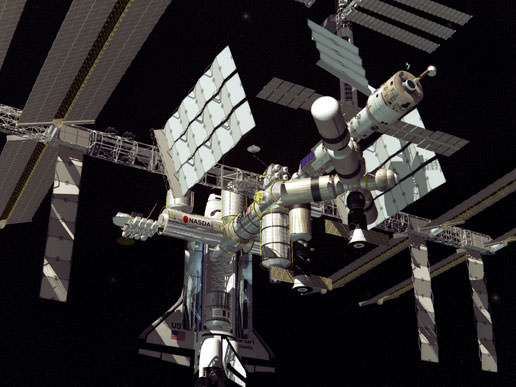[/caption]
If all goes well and space shuttle Discovery arrives at the International Space Station the end of February, there will be a distinctive configuration: all the international partners will have a vehicle docked to the completed ISS. With the shuttle program about to retire, this configuration will be unique enough – this is the only time it will happen during the shuttle program — that NASA is considering putting three cosmonauts/astronauts in one of the Soyuz capsules that are docked to the station, have them undock and fly around to take pictures of the entire complex.
The Soyuz could photograph the station, showing the ISS in its final, completed configuration, with the shuttle attached, along with the Russian Progress and Soyuz, the European ATV and the Japanese HTV-1.
NASA managers, engineers and contractors are meeting today, Feb. 18 in a Flight Readiness Review to discuss the photo op. Of course, the Russian space agency would have to go along with the idea, as the task would not be insignificant.
Anytime a spacecraft undocks, there is the possibility of a problem or malfunction, and with people involved, the problems multiply fairly quickly. If for some reason the crew could not re-dock, they would have to deorbit and return to Earth, and the ISS crew would all of a sudden be reduced from six to three. Of course, the shuttle crew would be there, but their stay would be limited.
If the plans gets the OK, the crew doing the photo-op mission would ber Alexander Kaleri, Oleg Skripochka and Expedition 26 commander Scott Kelly.

But you have to admit, the pictures and videos would be spectacular, and as things stand now, this would be the one and only chance to get a picture like this, a sort of family photo of the station and all the vehicles that support it.
The feat is not without precedence, however. The Russians took a similar photo on July 4, 1995, when the shuttle Atlantis was docked to the Mir space station, the first time a shuttle visited the Russian space station. Just before Atlantis undocked to return home, cosmonauts Anatoly Solovyev and Nikolai Budarin undocked in a Soyuz spacecraft and photographed the shuttle’s departure from a distance of about 300 feet.
There was a computer problem during the maneuver, however, and the cosmonauts had to dock manually and everything turned out just fine. And the picture was great, too.
The NASA Twitter feed reporting from today’s FRR meeting said the decision to do the photo op will probably not be made until during the STS-133 mission. NASA management is also deciding today when the Discovery mission will actually launch – right now it is scheduled for February 24, 2011 but they are weighing waiting until February 25, as the ATV Johnnes Kepler will arrive at the ISS on the 24th about 6 hours before the shuttle is scheduled to launch. If there were any problems with the ATV, the shuttle might have to stand down.


“showing the ISS in its final, completed configuration”
Not so fast, the Russian Nauka/MLM research module is scheduled to launch in 2012:
http://en.wikipedia.org/wiki/Nauka_%28ISS_module%29
An expensive proposition to get this ‘once in a lifetime’ photo op. but I’m all for doing it. Beyond testing systems on the Soyuz and ISS, it will refresh the crew’s training on departure procedures.
May be expensive, but not nearly as wasteful as spending 13 years to build a space station, and then letting it fall into the atmosphere and burn up in less than 7. I really hope they will find funding to continue the ISS mission for as long as it can be kept operational. Or at least have enough vision to not waste it entirely, just boost it to a higher orbit where it can circle indefinitely. Even if it does become a derelict, its better than the alternative. Let future construction use it as raw materials, its not like it has to go anywhere once you get it out of LEO and into a more stable orbit.
The picture your using is very outdated, here’s an accurate CG rendering
http://spaceflight.nasa.gov/gallery/images/station/issartwork/html/jsc2011e016372.html
I like this photo, as it shows the huge size of the Shuttle vs the station. With the shuttle we lose a big space-truck… pity. However, I do think that it should have been upgraded over the years in every way possible. Other launch systems just do not have the capacity in size and capability.
We did upgrade the Shuttles over the 30 years we flew them. If the Atlas V Heavy (29,000 kg) or Falcon 9 Heavy (32,000 kg) are ever built they will be able to lift more than the Shuttle (24,000 kg) is capable. Really the only capability we’re losing is the 25,000 kg worth of return cargo, but that is really way more than we need for the ISS.